Seven Impossible Interviews Before Breakfast #5:
Emily Jenkins — One of Our Favorite Writers
(According to Us)
 February 7th, 2007 by Eisha and Jules
February 7th, 2007 by Eisha and Jules
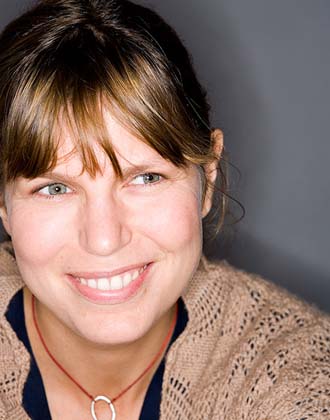 This author interview with the talented Emily Jenkins might seem a bit random. It’s our first one on our own blog (and, really, if you want to see some kickin’ author interviews that occur on a regular basis, you best head over to Little Willow’s author chats at Bildungsroman and the interviews by the nice folks over at Just One More Book!! . . . They have it goin’ on. And there are probably a slew of others we’re forgetting). Honestly, though, what happened is simply that we read one of Emily’s latest creations, last year’s Toys Go Out (published by Schwartz & Wade Books), illustrated by Paul O. Zelinsky, and we marvelled at the fact that she seems to be guided by quite the clever muse and that she keeps continually wow’ing us with the skillful writing in her children’s titles. She, in short, quickly became one of our favorite children’s book authors in the crowded landscape of children’s literature. So, we asked for an interview and were kindly granted one (and we appreciate it “very extremely hugely much” and feel like quite the “lucky ducks,” to quote her playful and colorful ’04 picture book title, Daffodil).
This author interview with the talented Emily Jenkins might seem a bit random. It’s our first one on our own blog (and, really, if you want to see some kickin’ author interviews that occur on a regular basis, you best head over to Little Willow’s author chats at Bildungsroman and the interviews by the nice folks over at Just One More Book!! . . . They have it goin’ on. And there are probably a slew of others we’re forgetting). Honestly, though, what happened is simply that we read one of Emily’s latest creations, last year’s Toys Go Out (published by Schwartz & Wade Books), illustrated by Paul O. Zelinsky, and we marvelled at the fact that she seems to be guided by quite the clever muse and that she keeps continually wow’ing us with the skillful writing in her children’s titles. She, in short, quickly became one of our favorite children’s book authors in the crowded landscape of children’s literature. So, we asked for an interview and were kindly granted one (and we appreciate it “very extremely hugely much” and feel like quite the “lucky ducks,” to quote her playful and colorful ’04 picture book title, Daffodil).
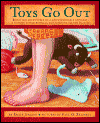 So, what stands out about Emily Jenkins? For one, her writing is so child-friendly and accessible that she makes it look like a cinch to write in such a manner, though we know it isn’t. In Toys Go Out (co-reviewed here), we meet Lumphy, a stuffed buffalo; Stingray, a stuffed — you guessed it! — stingray; and Plastic, who isn’t quite sure who or what she is but endeavors to find out — all the beloved toys of a young girl who “lives on a high bed with fluffy pillows.” And, as Eisha pointed out in our review, their concerns throughout this wonderfully quirky and practically unputdownable chapter book so effectively and entertainingly reflect those of a child audience — self-identity and insecurity; fear of the unknown; and good-‘ol-fashioned love and friendship — that we think it’s one of the stand-out titles of ’06 for sure. Best of all, as we pointed out in our review, it’s droll but without being insufferably whimsical or exceedingly quaint.
So, what stands out about Emily Jenkins? For one, her writing is so child-friendly and accessible that she makes it look like a cinch to write in such a manner, though we know it isn’t. In Toys Go Out (co-reviewed here), we meet Lumphy, a stuffed buffalo; Stingray, a stuffed — you guessed it! — stingray; and Plastic, who isn’t quite sure who or what she is but endeavors to find out — all the beloved toys of a young girl who “lives on a high bed with fluffy pillows.” And, as Eisha pointed out in our review, their concerns throughout this wonderfully quirky and practically unputdownable chapter book so effectively and entertainingly reflect those of a child audience — self-identity and insecurity; fear of the unknown; and good-‘ol-fashioned love and friendship — that we think it’s one of the stand-out titles of ’06 for sure. Best of all, as we pointed out in our review, it’s droll but without being insufferably whimsical or exceedingly quaint.
And then there’s 2005’s That New Animal (published by Farrar Straus & Giroux), illustrated by Pierre Pratt, which was chosen as a Boston Globe-Horn Book Honor title. This delightfully droll book gives us an amusing twist on the new-baby-in-the-family theme. If you’ve not yet found yourself acquainted with FudgeFudge and Marshmallow, the two heroes of the book, why then there’s simply a hole in your life. 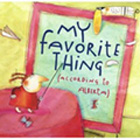 And in both the aforementioned Daffodil (published by Frances Foster Books, 2004) and in 2004’s My Favorite Thing (According to Alberta) (published by Simon & Schuster Children’s Publishing), Jenkins brings us two exuberant tales about individuality — the latter providing all kinds of great opportunities for debate amongst child readers, as they consider their favorites (Alberta is a “girl of particular tastes.” She likes orange — “anything that’s orange looks terrifically exciting”; she is a cat person; she does not like toothpaste; and she likes to stay in baths until her feet look “prune-y” — to name just a handful of her particular quirks).
And in both the aforementioned Daffodil (published by Frances Foster Books, 2004) and in 2004’s My Favorite Thing (According to Alberta) (published by Simon & Schuster Children’s Publishing), Jenkins brings us two exuberant tales about individuality — the latter providing all kinds of great opportunities for debate amongst child readers, as they consider their favorites (Alberta is a “girl of particular tastes.” She likes orange — “anything that’s orange looks terrifically exciting”; she is a cat person; she does not like toothpaste; and she likes to stay in baths until her feet look “prune-y” — to name just a handful of her particular quirks).
And those are just to name a handful of her titles . . . A new Emily Jenkins’ book, particularly one of her picture books, is always a cause for celebration here at 7ITBB. As Timnah Card at The Bulletin of the Center for Children’s Books put it in the lovely retrospective on Emily’s books for children:
“While Jenkins’ versatility allows her approaches to vary, each book displays an empathy for childhood with all its limitations and a humorous, individual voice . . . Through deft use of comparisons, engaging protagonists, and deep understanding sympathetically expressed, Jenkins explores the way children classify, arrange, and organize their world. In these picture books, liking and disliking specific things is everyone’s privilege, part of being alive, a way of distinguishing ours from theirs and me from her, but also a way of finding natural connections. From the viewpoint of a child, so often and peremptorily assigned belongings and even allegiances, Emily Jenkins’s books frame that all-important issue of personal preference, classification, and discernment exactly right.”
And, as Emily herself writes on her site in her biographical essay:
I have always been interested in picture books as a form, which stems (I suppose) from my background in theater. I am fascinated by the intersection of words and images – the way meanings of words can be altered by changing their presentation. An actor varies her intonation, or an illustrator changes a line – and the story is new.
Emily grew up in the Boston area in the 1970s, her father a playwright and her mother a pre-school teacher who exposed her to many picture books. She was an avid reader who “spent large parts of my life in imaginary worlds: Neverland, Oz, and Narnia, in particular,” and her first attempt at writing was at the age of eight. At Vassar College, she studied illustrated books from “an academic standpoint.” While a student, she worked for three years as a student assistant in Vassar’s lab pre-school, and after college she worked as an assistant teacher in a Montessori school. That same year, she co-authored a chapter book with her father (see below). Jenkins also worked as a freelance writer, primarily reviewing picture books for The New York Times Book Review, but she also worked for approximately five years as a magazine writer and critic. For a list of her magazine writing, visit this link at her site. She has also written two adult books, featured here at her site. As you will read below, she also has a doctorate in 19th century English literature.
Emily currently writes “full time (except when parenting) in a tiny little office in Brooklyn, accompanied by two plump and ancient cats.” Visit this link at her site for a collection of all her children’s titles. She also discusses four forthcoming picture books at her site, but we also took a moment to ask her about them ourselves. So, let’s get right to it, shall we? And thanks once again to Emily for taking the time to speak with us . . .
7ITBB: How does having a doctorate in 19th century English literature inform your writing?
Emily: Well, it must, every day — but it’s mainly intangible. Maybe this: I’ve given more than usual amounts of time to thinking about the relationship of text to image. And I taught Freshman composition for many years, so I have a reasonable command of English grammar and punctuation.
7ITBB: How did your experiences at Vassar’s lab pre-school and the Montessori school where you were an assistant teacher for 6-9 year olds inform your writing?
Emily: Those jobs made me realize I wanted to write for children. But not spend all day with them every day.
7ITBB: I (Jules, that is) have heard the children’s book author Jack Gantos say before that all children’s book authors do not live in little pink bubbles surrounded by cute, little bunnies, though that’s what the general public tends to think (and I’m totally paraphrasing his amusing comments there, but that was the gist of it). In preparing for this interview, we read and enjoyed your adult essays (in the “Sex” column via Salon, for one) and, particularly, the one in which you write about how it felt to give in to the bridal magazines, as the feminist that you are, when you got engaged (“Bridal Fantasies”). Are people (the aforesaid general public, that is) often surprised or shocked that you are someone who has published, for instance, an essay about your experience seeing your first porn film as a teen (“Porn Virgins”) yet someone who also writes so lovingly about domestic life in picture books aimed at children?
Emily: No one says a word — that I hear, anyway. Children’s book writers are adults, with adult lives and concerns. Most people realize it would be ridiculous to think otherwise. Besides, I rather disagree with Gantos: I am sure no one thinks Roald Dahl, James Thurber and Ian Fleming lived in pink bubbles with bunnies!
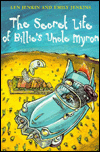 7ITBB: Tell us what it was like to write a middle-grade novel with your father, mailing chapters back and forth. Did you enjoy the process?
7ITBB: Tell us what it was like to write a middle-grade novel with your father, mailing chapters back and forth. Did you enjoy the process?
Emily: My father is a playwright and novelist named Len Jenkin. The Secret Life of Billie’s Uncle Myron (out of print, 1996) was my first published book, and I learned a tremendous amount from seeing my dad at work. He is very adept at structure and has an unbelievable and unusual way with words. His images are always startling and he’s a tireless reviser.
7ITBB: We read on your site that you love “seeing the words {you} write transformed by an illustrator’s imagination” and that it’s your favorite part of the picture book-making process. Is there one of your picture books that stands out in this manner? In other words, were any of them truly surprising to you in some way after the illustrations were added?
Emily: In Love You When You Whine I had written what I thought was a borderline sticky poem about maternal love. It was as honest and emotional as I could make it.
In the delightfully naughty and strange watercolors by Sergio Ruzzier, however, it became something closer to an eye-rolling catalog of surreal levels of childhood misbehavior. The love poem is still there, but there’s also an opportunity for children to gleefully identify with the rambunctious kitten, not only with her long-suffering mama.
For example, “Love you when you pour cereal on the floor” originally just meant, “when you dump your bowl of cereal out on the floor.” But Sergio’s Kitten has clearly got hold of like 48 boxes of Cheerios and is building sculptures and cities in the living room. “Love you when you hit someone” depicts not a child hitting a friend in a moment of anger (as I had imagined), but Kitten, with a package of eggs, pelting her friend with them. And her friend is a CHICKEN.
He is a brilliant man, Sergio.
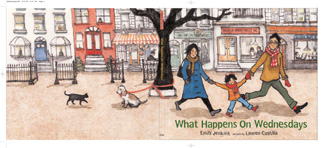
7ITBB: Please tell us more about What Happens on Wednesdays, due for a Fall ’07 release.
Emily: Oh, I am so excited about this one because it’s all about my neighborhood! It’s also about how children view space and time. Here’s the flap copy, which I wrote:
A preschooler marks the progress of her day, not by the clock but by what happens after lunch, after nap, after swimming, after the library – and after daddy comes home. She doesn’t map her neighborhood by street signs, either. Her morning walk to see dogs in the park takes her past the cat outside the deli, past her friend Errolyn’s building and the daycare where she used to go when she was little, and down the block to the bagel store.
The sounds, tastes, smells and sights of a multi-ethnic Brooklyn neighborhood, as seen through a child’s eyes and captured by Emily Jenkins and Lauren Castillo, will encourage children to make their own sensory maps and list the events in their daily schedules.
Lauren Castillo has a bunch of the art up on her site. She went to all my favorite locations in my neighborhood and sketched them, then made up her own landscape that feels just like my Brooklyn — but isn’t.
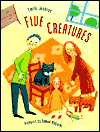
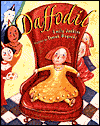 7ITBB: And can you talk about some of the illustrators you’re paired to work with in the near future, as highlighted on your site — Giselle Potter, Alexandra Boiger, Pierre Pratt? Were you able to choose them to work with and specifically pair up with certain titles of yours? And were you able to see some of their art work for the titles before-hand, such as you describe having done before with Tomek Bogacki {illustrator for 2001’s Five Creatures; 2004’s Daffodil; 2006’s Num, Num, Num!; and this year’s Daffodil, Crocodile}?
7ITBB: And can you talk about some of the illustrators you’re paired to work with in the near future, as highlighted on your site — Giselle Potter, Alexandra Boiger, Pierre Pratt? Were you able to choose them to work with and specifically pair up with certain titles of yours? And were you able to see some of their art work for the titles before-hand, such as you describe having done before with Tomek Bogacki {illustrator for 2001’s Five Creatures; 2004’s Daffodil; 2006’s Num, Num, Num!; and this year’s Daffodil, Crocodile}?
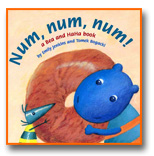
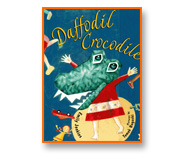 Emily: I am opinionated. That means sometimes it takes a long time to find artists that make both me and my editors happy. I hold out for illustrators I deeply admire and I am sure my editors are sometimes annoyed with me about it. But then once an artist is found, I try not to kibbitz too much and just let him or her do what he or she does best.
Emily: I am opinionated. That means sometimes it takes a long time to find artists that make both me and my editors happy. I hold out for illustrators I deeply admire and I am sure my editors are sometimes annoyed with me about it. But then once an artist is found, I try not to kibbitz too much and just let him or her do what he or she does best.
It took two years to find the right illustrator for the book Potter is doing. It’s called Sugar Wouldn’t Eat It, about a cat who will not eat the birthday cake her master gives her. I was so excited when Anne Schwartz (my editor) suggested Potter. I love her art. She conveys great joy coexisting with melancholy in a wonderful way – as in Three Cheers for Catherine the Great. But I haven’t met her, or seen any art for that story yet. Sometimes you don’t meet until a book is done, and maybe not even then.
Boiger is illustrating The Little Bit Scary People, which is about all those slightly frightening people in your neighborhood. Not the nice letter carrier and sweet librarian, but the bossyboots crossing guard, the cranky bus driver, the skateboard punk and the cafeteria lady. I haven’t met Boiger, either – though we have corresponded. And I’ve seen her character sketches. She drew this incredibly specific, punchy, quizzical little girl, lugging around a stuffed – hm, I am looking at it now and it might be a seahorse, but a really fat looking, mean-looking seahorse – in any case, lugging around a stuffed SOMETHING that is rather spiny. I loved her book While Mama Had a Quick Little Chat.
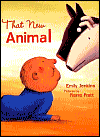 Pierre Pratt I worked with on That New Animal together. For that book I kibitzed on character sketches and a black and white dummy before seeing partly finished art and eventually finished art. That’s pretty usual for me at this point — to have three or four chances to speak my mind about the pictures. But Pierre lives in Montreal, so he’s not there when I see the stuff, and we didn’t meet until we won the Boston Globe/Horn Book honor for the book.
Pierre Pratt I worked with on That New Animal together. For that book I kibitzed on character sketches and a black and white dummy before seeing partly finished art and eventually finished art. That’s pretty usual for me at this point — to have three or four chances to speak my mind about the pictures. But Pierre lives in Montreal, so he’s not there when I see the stuff, and we didn’t meet until we won the Boston Globe/Horn Book honor for the book.
We email each other now, though. I sometimes try to email him in French, which is his first language, and make a total fool of myself parce que mon Français is strangely fused mit meine Deutch from graduate school — but he is very tolerant.
When I wrote a new dog story – Skunkdog — I knew I wanted Pierre to illustrate it. He paints the best dogs in children’s book illustration today – which is saying really a very very lot. They are supremely excellent dogs. In fact, he has done so many dog books he almost didn’t want to do any MORE dogs, so I am lucky he said yes to Skunkdog. He told me he spent a long time looking for the ugliest little beastie he could possibly draw. But I think she is still very lovable. Her name is Dumpling.
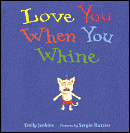 7ITBB: We love how Love You When You Whine (published by Farrar Straus Giroux, 2006) is a refreshing antidote to the gloopy, syrupy love-you-forever picture books out there. And how your “Recommended Love Books” on your site also do not highlight such rather maudlin titles (instead highlighting books, like yours, that more honestly depict the fierce but complicated love a mama has for a child). Did you specifically set out for the book to be such an antidote?
7ITBB: We love how Love You When You Whine (published by Farrar Straus Giroux, 2006) is a refreshing antidote to the gloopy, syrupy love-you-forever picture books out there. And how your “Recommended Love Books” on your site also do not highlight such rather maudlin titles (instead highlighting books, like yours, that more honestly depict the fierce but complicated love a mama has for a child). Did you specifically set out for the book to be such an antidote?
Emily: Actually, I set out to write a love poem. Fierce and complicated is just how it came out.
7ITBB: We think Toys Go Out is maybe the best talking-toy book since Winnie-the-Pooh. For those who haven’t read this on your web site, can you explain how the story originated? And why a stuffed stingray, exactly?
Emily: You guys are gonna make my head explode. Thank you.
I started out trying to write a story that would convey some of the anxiety I thought my cats felt when they went out in their cat carrier. “Where are we going, and how bad is it gonna be? It’s dark and smelly in here. Etc.”
The result was a picture book manuscript that didn’t work well – because it all took place in the dark. Three toys inside a backpack.
The story was rejected by all the editors I worked with, including the one who later bought it. She ended up calling me back and telling me she’d realized it wasn’t a picture book. It was the start of a middle-grade book, and would I write five more stories with the same characters?
Oh, and I am so sorry. I have no idea why a stuffed stingray. She just popped into my head.
7ITBB: In your review of Madonna’s books for children at Salon, you talk about the dearth of chapter books that are “pretty objects,” that there is that gap there in the publishing industry. You wrote: “Once children begin reading on their own, they generally don’t have access to those kinds of full-color pictures” {seen in her picture books, which otherwise you wouldn’t want to read to your daughter!}. Did you have this in mind while writing Toys Go Out? Zelinsky’s illustrations are not in color, but they are lovely and entertaining, and the book does stand out to us as a chapter-book-that-is-pretty/well-designed.
Emily: Oh, that Madonna review is so vitriolic, I almost hate to have people read it. I was exceedingly cranky that day.
Yes, of course! You should have seen me dancing around my tiny little office when they told me Zelinsky was going to do the illustrations, and that it would indeed be lovely paper, and all that. Of course, I wanted like 50 pictures, and there are only 8. But still. I love them a lot. Paul drew exactly what was inside my head. He has some superpowers, I suspect.
7ITBB: Yay! We read on your site that you will be writing another book about Lumphy, StingRay, and Plastic, illustrated again by Zelinsky. Please do tell more.
Emily: There is a garbage-eating shark that arrives in the household and causes much consternation.
7ITBB: We like to pose to people The Pivot Questionnaire, because who knew that knowing what sound or noise someone loves, for instance, could tell you so much about them. So, here it is then:
What is your favorite word?
Emily: Today? “Pumpkin.”
What is your least favorite word?
Emily: I love all words.
What turns you on creatively, spiritually or emotionally?
Emily: Creatively: walking.
What turns you off?
Emily: Noise. I like to write in silence.
What is your favorite curse word?
Emily: “Wanker” is pretty amusing.
What sound or noise do you love?
Emily: Laughter.
What sound or noise do you hate?
Emily: I don’t much like the telephone.
What profession other than your own would you like to attempt?
Emily: Baker.
If Heaven exists, what would you like to hear God say when you arrive at the Pearly Gates?
Emily: The cheese cave is down the hall on the right, the steam room on the left, and your grandfathers will be joining you for a beach walk at four.

Thanks for the nod, SITBB.
And thanks for this meaty, great-book-filled interview! Way to go!
Andrea
Fab interview, you two. It’s nice to know more about Emily Jenkins. Love “Toys Go Out.”
This is a great interview! Emily Jenkins sounds very cool.
Aww, I love her answer to what she’d like to hear God say. What a wonderful image.
Another great interview, E & J! Keep ’em coming!
very nice and interesting interview, i enjoyed it very much!
[…] when I was writing self-mocking autobiographies, I asked my friend, the author Emily Jenkins, how long it took her to pump out one of her board books. She said, ‘Twenty minutes. Of […]
[…] Wade, September 2011), the third set of stories about Stingray, Plastic, and Lumphy, written by Emily Jenkins and illustrated by Paul O. Zelinsky. The link will be […]
[…] you missed last week’s column, I wrote about Emily Jenkins’ latest set of stories about StingRay, Lumphy, and Plastic — Toys Come Home: Being the Early […]
[…] very animated pastel drawings, van Hout shows young readers a series of monster friendships. When Emily Jenkins wrote about van Hout’s Happy from last year at the New York Times, she wrote that he […]
[…] in Linda Ashman’s Rain!(Click to enlarge) This morning over at Kirkus, I write about Emily Jenkins’ newest picture book, Water in the Park: A Book About Water and the Times of the Day, released […]
[…] illustrator Stephanie Graegin is visiting 7-Imp, since last week (here at Kirkus) I wrote about Emily Jenkins’ newest picture book, Water in the Park: A Book About Water and the Times of the Day, released […]
[…] The biographical essay on this site talks about how I came to write books for children, and this interview at Seven Impossible Things Before Breakfast may be of […]
[…] three picture books — Viviane Schwarz’s How to Find Gold (Candlewick, March 2016); Emily Jenkins’ Tiger and Badger, illustrated by Marie-Louise Gay (Candlewick, February 2016); and Peter […]
[…] week, I wrote here about Emily Jenkins’s A Greyhound, a Groundhog (Schwartz & Wade, January 2017), as well as Steve Light’s Lucky […]
[…] Emily, and her work, is Emily’s own website. Here’s a few other interviews; Emily was interviewed on Seven Impossible Things Before Breakfast, a blog about books. She is also featured on Who Wrote […]